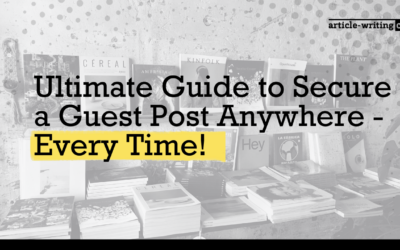Let’s just build some incredible content and we will be the kings/queens of the google search!
So you spend hours creating great content – researching it, interviewing professionals, and crafting a great narrative. Then the time comes to hit that “Publish” button, and…
***crickets***
Your rankings are still tanking, you’re nowhere near the first page for any of your keywords, and the only visits you get are from the bots crawling your website.
This is an all-too-familiar story to anyone who’s been in the content marketing business for more than a couple of months.
The bottom line is that while great content is a prerequisite to ranking on the first page of Google, it alone means nothing.
Great content becomes great when other websites on the Internet recognize it as such and start linking to it.
It all comes down to backlinks – inbound links from other websites that point to your homepage or other pages on your site.
Backlinks are the currency of the Internet – the more you have (from a variety of referring domains), the more visible your website will be in the search engine results pages.
Don’t believe me?
Here’s an extensive study from Backlinko that proves that Google wants to see a lot of different sites endorsing you before awarding you the #1 spot in the search results.
Here’s another study (from SEMRush this time) that places backlinks-related factors at the #5, #6, #7, and #8 place of importance when it comes to organic rankings.
Considering how important backlinks are to organic SERP rankings, they should never be left to chance. Smart digital marketers have a score of link building strategies they use to make sure that their sites get the ‘votes’ they need to climb the rankings ladder.
Here are 6 link building strategies that work like a charm in 2024. If your content is good, a mix of backlinks from all of these sources will all but guarantee that coveted #1 spot in Google result pages.
Let’s dig in!
I’ll start this list with authority guest posting – it’s one of my favourite link building strategies that works just as well in 2024 as it did in 2009. I expect it will work wonders in 2029, too, and here’s why.
Authority guest blogging is a painstaking process of finding quality sites in your niche, reaching out to their owners (or editors), and securing an opportunity to write an original blog post for them. The reward for your effort is an in-content backlink leading to your website.
Here’s an example of a guest post from Ahrefs (a really big player in the SEO tools niche):
You will want to find the same opportunities in your industry because the benefits of authority guest posting are too huge to pass up on:
- A great topical backlink for your website – it’s why you’re doing it, right? Just remember that contextual in-content links are way better than links appearing in the author bio section. For the editor to approve your in-content link, you need to make sure that it links to a piece of awesome content on your website (comprehensive guides and original research posts work best here).
- Qualified referral traffic – with authority guest posting, you will be getting in front of real readers who might be interested in what you’re selling.
- Authority-building & thought leadership – making a name for yourself in the industry means that other authority sites and bloggers will be more inclined to check out and link to your content even if you don’t ask them.
- Nurturing relationships with editors and bloggers – once you publish a few good guest posts, you’re in! Your next pitch to the same site is much more likely to be accepted, as are your pitches to other authority sites in your niche.
While guest posting is pretty straightforward in the world of link building strategies – you find the sites that are related to you and have high domain authority – it’s still a multi-step process.
Here’s how I approach it:
- Identify the sites you want to guest post for, and create a list.
- Find the right point of contact.
- Reach out with a short pitch (with a few topic suggestions).
- Follow editor directions when writing your content.
Finding relevant, high DA sites to guest post on
There are several ways to build your list of guest posting opportunities:
- Through manual search and cold emailing (you will find the most valuable assets this way but they will require more outreach work).
- Through source requests (sites asking for submissions via social networks such as Facebook or Twitter).
- By building relationships with webmasters and editors (involves social media interactions and blog commenting through which you become a familiar face and get asked to contribute).
To save time and money, you should focus on sites that allow you to pitch topics and rough outlines. There’s no point in pitching a 2000-word post only to have the editor tell you it’s not the type of content they are looking for.
Also, run your website picks through an SEO tool (Ahrefs, SEMRush, or MOZ or something similar) to see how well they stack up in terms of overall authority. Each of these tools has slightly different metrics but the higher the number (authority, traffic, backlinks), the better the opportunity. For example, if you’re using MOZ, anything above 60+ authority is worth your time.
Find the person responsible for guest posting opportunities
Sending an email to a generic contact address is a waste of your time. Even if that email gets read, what are the chances it will be forwarded to the right decision-maker? You’ve guessed it – slim to none.
Large websites will have a Team page that will usually tell you who you’ll be pitching when the time comes (for example, Joshua Hardwick is the Head of Content at Ahrefs). But, even then, there’s no guarantee that you will find their email address there.
I like to use LinkedIn for that – even if I can’t find an email address, I can still fire off a short message to the right person.
A simple “website name” + “content” search will usually give you all the information that you need. Here’s an example:
If I wanted to pitch SEMRush, I now know that I need to reach Maria because she’s in charge of guest posting.
If LinkedIn is not forthcoming with a contact (and that rarely happens), you can try searching through other social media platforms, including Facebook. In a pinch, there are paid services that can help you.
Send in your pitch
You have the sites you want to post on, and you have the right contact person for each of them.
Now is the time to send in your pitch.
Since this is cold outreach we’re talking about, you will want to keep a few things in mind if you want the person to even read through your email:
- Say who you are and what you want
- Demonstrate familiarity with the website
- Pitch three topics (based on content gap analysis)
- Provide related samples
Follow editor direction and deliver awesome content
When you get a reply to your pitch, you will probably have to work with the editor on fine-tuning the topic.
It’s also likely that you will get additional instructions on how to structure and format your text, what images to use, and how to link to outside content. Some websites have guest posting guidelines they expect you to stick to.
Follow these directions to the letter!
You don’t want to aggravate the editor you’re working with. The bottom line here is that the editor expects well-thought-out, useful, and insightful content. And, they know what their audience wants to read.
Following their instructions will help you create a more targeted piece of content, which is your goal in the first place.
While guest posting is one of the great link building strategies, doing it right can be exhausting.
The time that goes into researching, pitching, the back and forths with the editor, and creating great content might not be something you’re willing to part with. If that’s the case, reach out to AWC for GP Outreach and we’ll get you started. Our authority guest posting service is completely hands-off – we research the sites in your niche, pitch them, and write the content. You get a detailed report at the end of the month, and spend the rest of the time watching your organic rankings go up!
Help A Reporter Out (HARO)
HARO – Help A Reporter Out – is a service that reporters from all over the world use when they need information on topics they are writing about.
The reporters submit a request, the website notifies the potential sources to pitch their answers, and the reporters then pick the most relevant answers to feature in their piece. The understanding is that the report will get relevant information from a qualified source, in turn mentioning them and linking to their website.
In the last couple of years, HARO has become the backlink strategy for savvy marketers who understand that link power should always be coupled with qualified traffic and authority-building exposure. No wonder since this link building strategy can potentially result with a link from The New York Times, The Washington Post, and dozens of other high-profile publications.
To use HARO, you will need to sign up as a source. The signup is free but there are a couple of paid tiers that come with some perks – the ability to send out a prefilled profile when answering the requests, and the ability to set up keyword alerts for the topics you’re interested in. With the free profile, you will get three email notifications every day, Monday through Friday.
I’d recommend the standard plan to everyone except marketing agencies, who can benefit from targeting multiple keywords for a couple of their clients. The premium plan is for those with deep pockets who need the flexibility of multiple user profiles and unlimited keywords.
Most reporter requests are time-sensitive – you won’t get much use out of HARO if you’re a Johnny-come-lately. Also, thousands of marketers are now using HARO to earn backlinks and exposure for their clients. You need to master the art of storytelling in your pitches or risk being skipped over. You can have the most pertinent information in the world but if you can’t package it into a few interesting lines of writing, you can forget about your answer being picked.
Here are a few tips on writing a HARO pitch that will help you stand out from the crowd:
- Use a paid account – you will be able to find industry-related requests more easily.
- Set up an industry-relevant profile – list your qualifications and your experience to be sent out automatically instead of having to write them out in every pitch.
- Send your answer in quickly – speed is of the essence since most of these journalists are working against the clock.
- Lead with the right credentials and other relevant information – immediately establish yourself (or your client) as an expert in the field. Include a link to a relevant bio with contact information and a downloadable photo.
- Tailor each response to the request – demonstrate that you’ve read the request by keeping your answer on-topic and by following the instructions.
- Answer the question clearly – there’s no ideal word count here but try to keep your answer under 400 words. Format your text, use bullet points, and link to additional relevant information.
- Provide a quote or two if appropriate – if the reporter is looking for opinions from industry experts, make it easier for them to use your answer by providing a quote or two that they can copy verbatim.
In addition to being a potential source of great backlinks, HARO is invaluable for exposure and authority-building. At Powerful Outreach, we’ve spent years building relationships with writers and editors at various publications. Contact us today to cut through the clutter, ensuring that it’s your quote that gets used in the next article that The New York Times publishes about your industry!
Targeted Press Outreach
Instead of waiting for a reporter to reach out for information – and hoping that it’s you they choose to feature – why not find something newsworthy about your business that publications will want to publish?
I’ve written A LOT about press releases and press interactions – it’s what we at Powerful Outreach stake our reputation on, after all.
Still, I wanted to give a shout-out to the good ol’ press release here because it’s still an underused (but, often, abused) backlinking strategy. So let’s get to it.
What’s a press release anyway?
A press release is a short write-up (usually a one-pager) that focuses on breaking news, product launches, anniversaries, partnerships, and other company news.
When it comes to press releases as a link building strategy, a lot of companies still bring a cannon to a knife fight so to speak. That’s to say, they blast their release all over the Internet, and then wonder why the heck their rankings are plummeting instead of skyrocketing.
Here’s the thing – Google doesn’t like blasts of any kind. Not comment blasts, not roundup blasts, and not press release blasts.
For a press release to benefit your backlinks profile, it needs to tick two important boxes:
- It needs to be news-worthy – the audience it targets need to find it interesting, actionable, funny, surprising, praise-worthy, shocking, or share-worthy. In an ideal world, it will be all of the above but you should aim at it being at least two of these things.
- It needs to be published by the right media – 300 links mean nothing if they are from publications that have zero connection to your industry. If you’re a wood sculptor, getting a link from Popular Woodworking, Good Woodworking, and The Woodworker will be much more beneficial for your rankings (and your traffic) then getting a mention on Fox News.
So instead of using a syndicated PR service, do the legwork and identify those news sites that can really help you reach your target audience. A backlink from them will carry a lot more SEO weight, and it definitely won’t backfire and hurt your rankings.
If you don’t have the time to devote to this – but want to use press releases as a part of your link building strategy – contact AWC today. We’d love to use our media connections to help you grow your business.
If you insist on tackling this yourself, you need to know how to write a great press release:
- Find your angle – whatever the information you’re pushing out, frame it so that your target audience appreciates it. A merger becomes an opportunity to lower your prices; a new CEO heralds a new customer-centric approach; a company milestone translates into an opportunity to reward some of your most faithful customers.
- Make your lede stand out – when writing your first paragraph, think like a journalist. Answer the 5 W’s – who, what, where, when, and why – as succinctly as you can, and get your main point across immediately.
- Use the inverted pyramid writing style – don’t bury your lead. The most important information goes at the top in a press release. If you need to elaborate on something, use your third and fourth paragraphs to do it.
- Write clearly and with focus – stream of consciousness writing works great for New Age novels but not so much for PR pieces. Cut the fluff out of your press release and focus on one key takeaway.
- Include contact and company information – reserve your last paragraph for the boilerplate copy. Here, you will include your contact information and links, as well as a brief summary of your company’s history and activities.
If you’re doing manual outreach (as you should), remember that there are good times to reach out and there are bad times. If you want to bury a story, send it out during the graveyard shift – Friday afternoon. To increase the chances of it getting picked up, send your PR piece on a Tuesday morning between 9 and 10 AM – you’ll avoid the Monday rush but still get out early in the week.
Brand Mentions In Link Building Strategies
Sometimes, other websites will publish content that mentions your brand.
When they do that, it’s a coin toss as to whether or not they’ll include a link back to you. In my experience, only authors writing for top-tier publications are diligent when it comes to linking out to original content.
Once you notice a mention of your brand, product, service, proprietary data (or even of your CEO or other high-profile employees), it’s time to do some link reclamation work.
Link reclamation is a process that involves finding the mentions of your brand and then reaching out to websites and authors to include a live link back to a valuable/appropriate page.
Here’s an example of just a brand mention in a post talking about marketing success stories:
Not only did this site mention Easy Lunchboxes in the post – they really liked their marketing approach and heavily featured it. Still, you won’t find an outbound link anywhere in that post.
Since the link is not included, this provides the SEOs working for Easy Lunchboxes with a backlink opportunity that just about ripe for the picking – all they need to do is reach out and ask for it!
I use this 3-step link reclamation process at least once a month to turn valuable brand mentions into more valuable backlinks:
Get notified about your brand mentions regularly
While it’s relatively easy to do a one-off brand mentions search using a number of tools (including BuzzSumo and Brand24, among others), I prefer to use Ahrefs alerts and get notified instantly.
The setup is easy – just remember to exclude your own website and other properties you control in order to reduce the number of false positives.
Check to see if the backlink is already included
Once you get an email notification from Ahrefs, follow the link to the post (it will be supplied). If the post already links to your website there’s no need to do anything. If it doesn’t, move on to the next step.
Reach out to the author/website and try to secure a link
If you can invest some time to find the author of the post that mentions your brand, you’ll increase the chances of getting what you’re after. Often, they have direct access to the post and can edit it. Even if they don’t, they know which editor to contact to get it done.
I suggest keeping your ask short and polite.
Resource Page (or Tool) Development
With this link building strategy, you’re taking what everyone else is doing and turning it on its head.
So, for example, instead of investing time and effort in getting a backlink from “100 Best Paleo Diet Resources of All-Time”, you will be creating a resource page titled “200 Best Paleo Diet Resources”.
With time and effort, that particular page will become a backlinks magnet. Online tools work just as well as resource pages in this case.
This link building strategy is more of a long play than an instant win but it does pay off. Here’s an example from Smart Passive Income:
1.1K backlinks coming from industry-related sites are lending a nice organic boost to this particular page.
Online tools can work even better for link-building. Here’s an example from Nomadlist, a website that allows freelancers to quickly scan areas of the world for cheap accommodation, fast Internet, and fun beaches – three staples of the digital nomad lifestyle.
Nomadlist gave digital nomads an easy-to-use tool that helps them plan their travel and work. Those nomads gave back to Nomadlist by spreading the word, and linking to the website nearly one MILLION times!
Great resource pages and tools take a while to create but they have the potential to become a long-term backlinking asset. This doesn’t mean that they won’t require an initial push, both in terms of quality and marketing effort.
Here are the 5 things you need to think about when creating these resources:
- When creating a new resource page, think big – to make an impact, double the number of resources that can be found on the best-ranking page for that niche. If you’re making a tool, solve an existing problem more elegantly and efficiently than anyone else.
- Link out to super-valuable content – find the best topic-specific content in your niche to link out to. If a specific topic is not covered well, consider writing it up yourself – it will give you an opportunity to do some internal linking, and to rank for an additional set of keywords.
- Reach out to everyone you’re linking to – let them know that their piece of content made it to your ultimate resource page. Politely ask if they can link back to it, and share the news with their readers (via their email newsletter and social pages).
- Reach out to large industry sites – these sites regularly publish listicles covering top tools and resources. Bring your resource to their attention as soon as possible.
- Regularly promote your effort on social media sites – Facebook works great for this since you can easily find groups full of people who would be interested in your resource page or tool. Spending $20 per month on Facebook ads is also an option.
As I’ve already mentioned, building an exhaustive resource page or a valuable tool is one of the best long-term link building strategies. Don’t get discouraged if you’re not landing links in the first month. It takes time for these pages to start ranking but if you did a good job, they acquire backlinks naturally as they age.
The Moving Man Method (Broken Link-Building)
Backlinko’s Brian Dean knows a thing or two about link-building. He grew his now 7-figure business from scratch and gave other SEOers the run for their money by inventing (and perfectly executing) great link building strategies.
One of those strategies is called The Moving Man Method.
It’s an easy way to do broken link building when you know that an authority site changed their domain name or moved a resource to a new URL.
When any of these things happen, links pointing to the property that’s affected are at risk of being broken. Even if the company is making an effort to redirect everything, glitches still happen, not to mention that other websites are now using an outdated name.
A while back, SEOMoz changed their name to just MOZ. By reaching out to webmasters to warn them about the wrong anchor (which was usually SEOMoz) and about a potentially broken link, SEOer and marketers were able to acquire great backlinks. This is especially true if they put in the work and offered high-quality content as a substitute.
There are 3 main steps to executing the Moving Man Method successfully:
- Knowing where to look for outdated sources
- Checking their backlinking profile
- Reaching out with good replacement content
Let’s go through them step by step.
STEP 1 – Find sites that have changed their name, moved, or shut down
My favorite method of identifying outdated resources is finding businesses that changed their name or went through a rebrand recently. Press releases work great for that.
STEP 2 – Find backlinks pointing to the old domain
Once you identify a website that’s going through a rebranding or changing their domain, it’s time to check their backlinks profile. I use SEMRush for this but you can use a number of different tools, including Ahrefs and MOZ.
Instead of sifting through all these links manually, use the export feature that’s integrated with your tool. With SEMRush, I get a CSV file that allows me to sort all the backlinks using the authority metric. This way, find the most valuable opportunities in under a minute and can focus on my outreach immediately.
Pro Tip: Most reports will also give you an option to sort the results by broken (lost) links. These are your best bets, even when using the Moving Man Method for broken link-building. Even though all of these sites should update their links because they reference outdated information, the sites with broken links NEED to do it if they want to avoid frustrating their readers.
STEP 3 – Reach out and offer a quality link replacement
When reaching out to webmasters to warn them that they are linking to an outdated or a broken link, it pays not to be pushy.
Sure, you’re doing them a favor (in most cases) but no one owes you a link, really.
Lead with value (the heads up about the broken link) and end with value (providing a link to your awesome piece of content they can use as a replacement for the dead link).
Here’s how I would craft a pitch to send to one of the targets in a publication I’m courting:
- It’s addressed to the webmaster/editor – someone who can act on it.
- It identifies the broken link and its location on their site.
- An effort has been made to locate original content (it doesn’t exist).
- The replacement link is relevant to the content.
- The ask is more of a suggestion than a request.
As far as broken link building strategies go, I like this specific one because it’s much less time-consuming than the traditional variant. If you hear about a website in your industry that’s rebranding, changing domains, or simply shutting down, you now know which backlinking strategy to use to profit from it!
What the experts say
Don’t just take my word for link-building. I chatted with some of the best in the business for their take on backlinking, too.
SEO consultant and expert Eli Schwartz believes that backlinks for the sake of it are of dubious value. “It’s impossible for anyone, possibly even a Google employee, to know if a backlink is helping a site to rank better. Links are just one piece of a vast and complex algorithm, and each link is a sub-part of that factor,” he said. “That being said, links are very important for ranking but rather than putting effort into acquiring individual links, the site should instead develop a strategy for how to make themselves attractive to authority publications. This might include producing unique content, developing data or providing a useful tool.”
What’s Your Favorite Backlinking Strategy for 2024?
There are at least a dozen more link building strategies that I could have included into this post. I didn’t because a) it’s too long as it is, and b) I believe these strategies come with a good return on investment.
However, maybe I’m missing the method destined to become the backlinks powerhouse of 2024? If you think that’s the case, leave a comment below and let us all know about it!

David is the Founder and Director of article-writing.co, the fastest-growing content creation agency in North America. He has transformed companies by offering high-quality content that has impacted their SEO ranking, revitalized websites with engaging and industry-relevant blogs and website copy, and championed successful email campaign copy.




